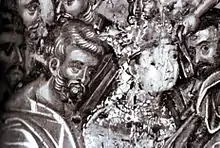Maria Angelina Doukaina Palaiologina
Maria Angelina Doukaina Palaiologina or Marija Angelina Nemanjić or Anna Maria Angelina Doukaina Palaiologina (Greek: Μαρία Αγγελίνα Δούκαινα Παλαιολογίνα, Serbian Cyrillic: Марија Ангелина Немањић; 1349 – 28 December 1394) was a Byzantine Greek-Serbian aristocrat and the self-proclaimed basilissa (Greek: βασίλισσα; Empress, queen) of Epirus from 1384–85, succeeding the rule of her murdered husband Thomas Preljubović. Maria and her husband were a famed couple as patrons of the arts during Tomo's rule of Ioannina from 1366 to 1384.[1] She is portrayed in the icons.[2]
| Maria Angelina of Epirus | |
|---|---|
 Thomas and Maria Paleologina | |
| Basilissa of Epirus | |
| Reign | 23 December 1384 – February 1385 |
| Predecessor | Thomas Preljubović |
| Successor | Esau de' Buondelmonti |
| Consort of Epirus | |
| Tenure | 1366 – 23 December 1384 (as wife of Thomas) February 1385 – 28 December 1394 (as wife of Esau) |
| Born | 1350/51 |
| Died | 28 December 1394 Ioannina, Despotate of Epirus |
| Spouse | Thomas Preljubović Esau de' Buondelmonti |
| House | Nemanjić |
| Father | Simeon Uroš |
| Mother | Thomais Orsini |
| Religion | Eastern Orthodox Christian |
Life
Maria was the daughter of the Serbian Emperor of Thessaly, Simeon Uroš, the half-brother of Emperor Stephen Uroš IV Dušan of Serbia (Nemanjić dynasty), and Thomais Orsini. Her maternal grandfather was John Orsini of Epirus. In 1361, Maria, then only 12 years old, married Thomas Preljubović, who was appointed the governor (despot) of Epirus in Ioannina by her father in 1366. Popular with her subjects, she was allegedly mistreated by her husband and supposedly connived in his murder on 23 December 1384.
The population of Ioannina acclaimed Maria as ruler. She used the title of basilissa, female form of basileus.[3] She summoned her brother John Uroš Doukas Palaiologos (who became a monk in Meteora monastery by the name of Joasaph)[4] to advise her in the affairs of state, though he didn't stay long.
John Uroš suggested that Maria marry Esau de' Buondelmonti, one of the Latin noblemen captured by Thomas in 1379. It has been alleged[5] that Maria was already enamored of the captive before the murder of her husband, and that this affair had resulted in the assassination of Thomas.[5] Of course, all of this is pure conjecture.
Maria married Esau ("who sought recognition from Byzantium") in February 1385. Maria survived for a further decade, dying on 28 December 1394. She was 55.
Upon Esau's assumption of power, John Uroš left for Meteora where he was tonsured and took the name of Joasaph. He died in 1422.[4][6]
The Chronicle of Ioannina, so hostile towards Thomas Preljubović, describes Maria in very flattering terms; the Byzantine historian Laonikos Chalkokondyles, however, describes her as an unfaithful wife of questionable morality. Both accounts may be biased. Maria does not appear to have had surviving children from either marriage.
References
- Byzantium: Faith and Power (1261–1557). 2004. ISBN 978-1-58839-113-1.
- "Byzantion: Revue Internationale des Études Byzantines". 2002.
- "Historical Studies". 1968.
- "Saint Joasaph of Meteora". April 20, 2016.
- Fine, John V. A.; Fine, John Van Antwerp (1994). The Late Medieval Balkans: A Critical Survey from the Late Twelfth Century to the Ottoman Conquest. ISBN 0-472-08260-4.
- Panou, Eirini (2018-05-11). The Cult of St Anna in Byzantium. ISBN 978-1-317-03678-4.
Sources
- Fine, John V. A. Jr. (1994) [1987]. The Late Medieval Balkans: A Critical Survey from the Late Twelfth Century to the Ottoman Conquest. Ann Arbor, Michigan: University of Michigan Press. ISBN 0-472-08260-4.
- Kazhdan, Alexander, ed. (1991). The Oxford Dictionary of Byzantium. Oxford and New York: Oxford University Press. ISBN 0-19-504652-8.
- Miller, William (1908). The Latins in the Levant: A History of Frankish Greece (1204–1566). London: John Murray. OCLC 563022439.
- Nicol, Donald M. (1984). The Despotate of Epiros, 1267–1479: A Contribution to the History of Greece in the Middle Ages. Cambridge: Cambridge University Press. ISBN 978-0-521-13089-9.
- Soulis, George Christos (1984), The Serbs and Byzantium during the reign of Tsar Stephen Dušan (1331–1355) and his successors, Dumbarton Oaks, ISBN 0-88402-137-8
